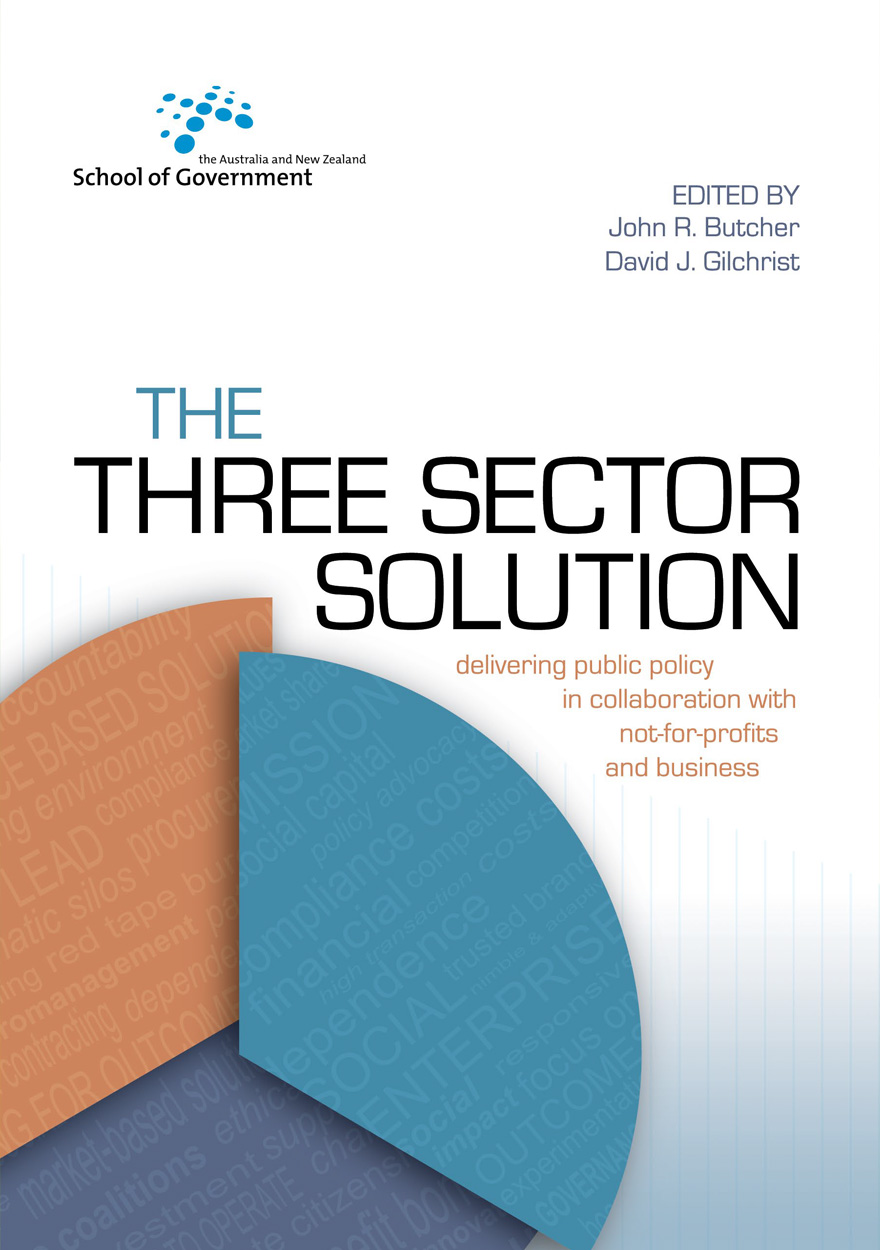Author: Kate Sunners
A note to our avid readers – by her own admission, Kate is our very own Public Policy Nerd, and proud of it. In this blog, Kate presents her take on this new academic publication.
The Book
The Three Sector Solution is an in-depth examination of the issues informing relationships between sectors of Australian and New Zealand Government, nonprofits and business. The backdrop: “market-focused approaches to Government investment in the NFP sector” (5).
Born of the speaking topics of the workshop ‘Cross-Sector Working for Complex Problems: Beyond the rhetoric’, The Three Sector Solution is a really meaty, meaningful discussion of the pros and cons of (and learnings from) the way the three sectors have historically worked together, examining a number of past and existing partnerships for learnings, and looking ahead to future collaborative frameworks.
At the same time, the text acknowledges the difficulties of collaborating on ‘wicked problems’, and how a change from the historical role of nonprofits as “mendicant to the various Government agencies that have provided funding for service delivery” (4) to 90s style market mechanisms, has impacted the relationship of nonprofits and Government.
The Highlights
I can’t stress enough the gold that is in this book in terms of practical tools for nonprofits (from understanding barriers to reporting through to the processes required in various circumstances for collaboration); as well as in understanding the nonprofit, Government and Business collaboration space more generally. The authors provide insightful, evidence-based research and information that can’t be summed up in one book review. Nevertheless I’m going to try (or at least tell you my favourite bits).
The first chunk of gold comes from the chapter by Shergold (boom tish – sorry), who recognises that sometimes Government lags behind the business and nonprofit sectors, particularly in “identifying policy-based evidence to justify a political outcome that has already been decided,” when, he says “there is far greater merit in actively working with collaborators [universities, think tanks, research institutes and consultancy companies] in pursuit of evidence-based policy with which to influence political decisions” (28). And perhaps with the Australian Prime Minister’s Community Business Partnership – including a parliamentary meeting of the minds which Jo attended in 2015 – we are beginning to see this emerging.
Tessa Boyd-Cain’s chapter examines the positive spillover effects beyond specific projects funded by Government, and how to account for them in funding models, while Leeora D. Black tackles barriers to social impact investment which in Australia could reach $32 billion in a decade (114). Black points to Government facilitation as one way to overcome barriers, citing the Social Impact and Social Benefit Bonds currently taking shape in several states across Australia. She reflects on the United States’ ‘B Corporation’ model and suggests that this new business structure requiring a positive social or environmental impact in addition might provide greater encouragement for business to engage with social investment.
Krystian Seibert gives a great account of the ACNC as an exemplar of successful cross-sector collaboration, and discusses the necessity for ACNC regulation flexibility and mid set-up ‘tweaks’ when working with a ‘coalition of subsectors’ like the nonprofit sector, which defies homogeneity.
Robyn Keast’s chapter shines a light on the processes, essential characteristics and supporting mechanisms required for successful collaboration – an invaluable resource for those working on setting up interagency or nonprofit/Government collaborations.
There’s quite a bit of discussion about funder reporting reforms to ensure that reporting is working towards social outcomes, not getting in the way of them, ensuring they become a “real-time strategic resource for the ongoing management of services and adjustment of service delivery” (191).
Dale Tweedie identifies from an in-depth study, including interviews with staff, directors and NFP regulators, that the three main barriers to nonprofits providing accountability reports are:
1) reporting that does not improve service quality;
2) NFP boards that lack active members; and
3) red tape reduction that might threaten minimum service standards (216).
Perhaps one of the most interesting chapters for me as a social science/public policy/evaluation nerd was by Rodney Scott and Ross Boyd on the learnings from the NZ Government’s push towards Public Service collaboration around outcomes. From 2002 NZ departments were required to “describe how the outputs they produced contributed to outcomes through an outcomes framework or intervention logic” (236). The new focus was intended to create interagency collaboration on ten pre-decided results with specific % decreases and increases specifically set to be challenging and urgent targets (ie. % 15 reduction in crime rate, 20% reduction in violent crime rate and 25% reduction in youth crime). Each result was given its own measure (ie. Number of reported crimes; number of reported violent crimes and number of court appearances by 14-16 year olds in previous 12 months).
There have been “successes achieved in areas that have been resistant to previous attempts at change” (241), and above this Scott and Boyd point out that having the targets and measures has produced far more of a result through departmental collaboration than has been seen in prior collaborative efforts. Early evidence of success seemed to provide the drive to continue. There were some problems however: in some cases the results set were not appropriate to the social issue and this affected the outcomes; there may have been some cherry-picking to produce desired outcomes; a mismatch between result, target and measure; and occasionally the indicators used in measures were off. These are great learnings to have been able to share!
The Wrap-Up
I’m saving the fourth part of the book ‘New Tools for Policymakers and Practitioners’ for some light bedtime reading. I’m still digesting the great ideas and findings from the first three parts, and some of the information has obviously been useful as I’ve referred to it in conversations since reading! Just an all-round great resource and, while those unused to academic reading might not be quite as ebullient about it as me, its content is worth it!
The Three Sector Solution is a publication of the Australia and New Zealand School of Government put out by ANU Press, edited by John Butcher and David Gilchrist, and is available in print for $45 or for free download as pdf.
{loadposition blogsocialshare}


